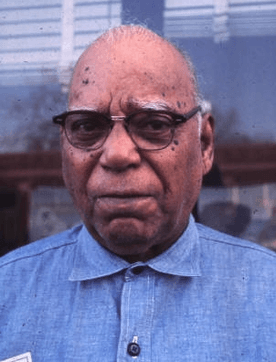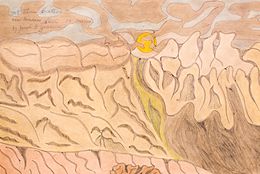Joseph Yoakum facts for kids
Quick facts for kids
Joseph Yoakum
|
|
|---|---|
 |
|
| Born |
Joseph Elmer Yoakum
c. February 22, 1891 Ash Grove, Missouri, U.S.
|
| Died | December 25, 1972 (aged 81) Rock Island, Rock Island County, Illinois, U.S.
|
| Education | Self-taught |
| Known for | Illustration, drawing |
| Movement | Outsider art |
| Patron(s) | John Hopgood, Whitney Halstead, Ray Yoshida |
Joseph Elmer Yoakum (born around February 22, 1891 – died December 25, 1972) was an American artist. He taught himself how to paint. Joseph Yoakum was of African-American background and may have also had Native American family. He became famous for his landscape paintings, which are part of a style called outsider art. He began creating art when he was 76 years old. In the last ten years of his life, he made more than 2,000 drawings. These drawings showed places he remembered or imagined.
Contents
The Early Life of Joseph Yoakum
It can be hard to find exact details about Joseph Yoakum's early life. He sometimes said he was part African, French, and Cherokee. A newspaper writer named Will Heinrich said that Yoakum's life story was "tricky" because it wasn't well recorded. Yoakum himself sometimes told different versions of his story.
His birth year is listed as 1886, 1888, or 1891. His military records say he was born in Springfield, Missouri. However, the 1900 U.S. census shows a 9-year-old Joe Yoakum in Greene County, Missouri. This record says he was Black and that his father was born in Indian Territory. His father, John Yoakum, was listed in the 1880 census as Black and born in the Cherokee Nation.
Yoakum was born in Ash Grove, Missouri. But he often told a story that he was born in Arizona in 1888. He claimed he was a Navajo Indian from the Window Rock Navajo reservation. He was very proud of his Native American heritage, even if it was exaggerated. He would say "Navajo" as "Na-va-JOE," sounding like his own name. He spent his early childhood on a farm in Missouri.
Traveling with Circuses
When Joseph Yoakum was nine years old, he left home. He joined the Great Wallace Circus. He worked as a bill poster, putting up advertisements for the show. He also traveled across the United States with other famous shows. These included Buffalo Bill's Wild West Show and the Ringling Brothers circus. He worked with five different circuses in total. Later, he even traveled to Europe by hiding on a ship.
In 1908, he came back to Missouri. He started a family with his girlfriend, Myrtle Julian. Their first son was born in 1909, and they got married in 1910. Around 1916, he worked in a coal mine to support his family.
Serving in the Army and Later Life
Yoakum joined the United States Army in 1918 during World War I. He was part of the 805th Pioneer Infantry. His job was to repair roads and railroads. After the war, he traveled around the United States. He worked many different odd jobs. He never went back to his first family. He later married again and moved to Chicago.
In 1946, Yoakum spent some time in a hospital in Chicago. He soon left and by the early 1950s, he began drawing regularly.
Joseph Yoakum's Artistic Journey
By 1962, Joseph Yoakum was living and painting in Chicago again. In 1968, a man named Tom Brand owned a printing business. He was delivering some items to a coffee shop called "The Whole." There, he saw Yoakum's colored pencil drawings. He was very impressed by them.
Brand knew the Ed Sherbyn Gallery in Chicago. He convinced Sherbyn to show Yoakum's artwork. Brand even printed his own poster for this art show. A newspaper writer, Norman Mark, wrote an article about Yoakum. It was titled "My drawings are a spiritual unfoldment." This article was printed on the back of the poster.
Brand told his artist friends about Yoakum. One of these friends was Whitney Halstead. Halstead was an artist and a teacher at the School of the Art Institute of Chicago. He became the biggest supporter of Yoakum's work during his lifetime. Halstead believed that Yoakum's life story was "more invention than reality." He thought it was "in part myth," like the life Yoakum wished he had lived.
Becoming Known in the Art World
In 1967, Joseph Yoakum's art became known to the wider art community. This happened when John Hopgood, a teacher at Chicago State College, saw Yoakum's art. He saw it hanging in Yoakum's studio window and bought twenty-two of his pictures.
A group of students and teachers from the School of the Art Institute of Chicago became interested in his work. These included students like Roger Brown, Gladys Nilsson, Jim Nutt, and Barbara Rossi. Teachers like Ray Yoshida and Whitney Halstead also helped promote his art. In 1972, just one month before he passed away, Yoakum had his own art show. It was held at the famous Whitney Museum in New York City.
Yoakum's Unique Style
Yoakum started by drawing places he knew, like Green Valley Ashville Kentucky. This helped him capture his memories. But then he began to draw imaginary landscapes. These were places he had never visited. Examples include Mt Cloubelle of West India or Mt Mowbullan in Dividing Range near Brisbane Australia.
He would draw outlines with a ballpoint pen. He rarely made mistakes or corrections. Then, he would color his drawings inside the lines using watercolors and pastels. He was known for his natural, flowing shapes. He always used two lines to show land masses in his drawings.
In the last four months of his life, Yoakum's art changed. He started using pure abstract shapes. One example is his drawing Flooding of Sock River through Ash Grove Mo [Missouri] on July 4, 1914 in that [waters] drove many persons from Homes I were with the Groupe leiving [sic] their homes for safety. This painting was one of his works about his own life.
In 2021, the Museum of Modern Art showed more than 100 of his artworks. The exhibition was called Joseph E. Yoakum: What I Saw. It was put together by the Art Institute of Chicago, the Museum of Modern Art, and the Menil Drawing Institute.


